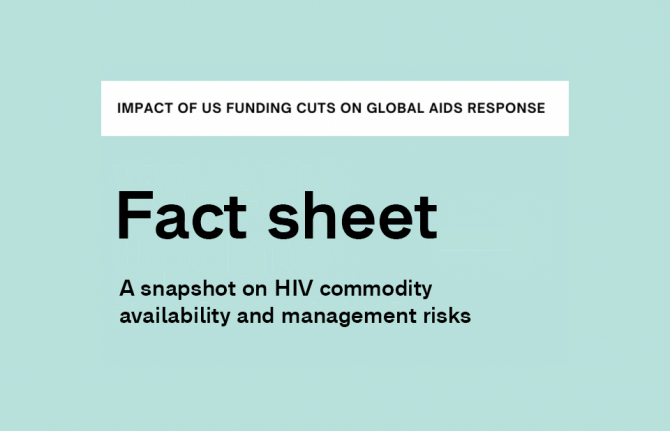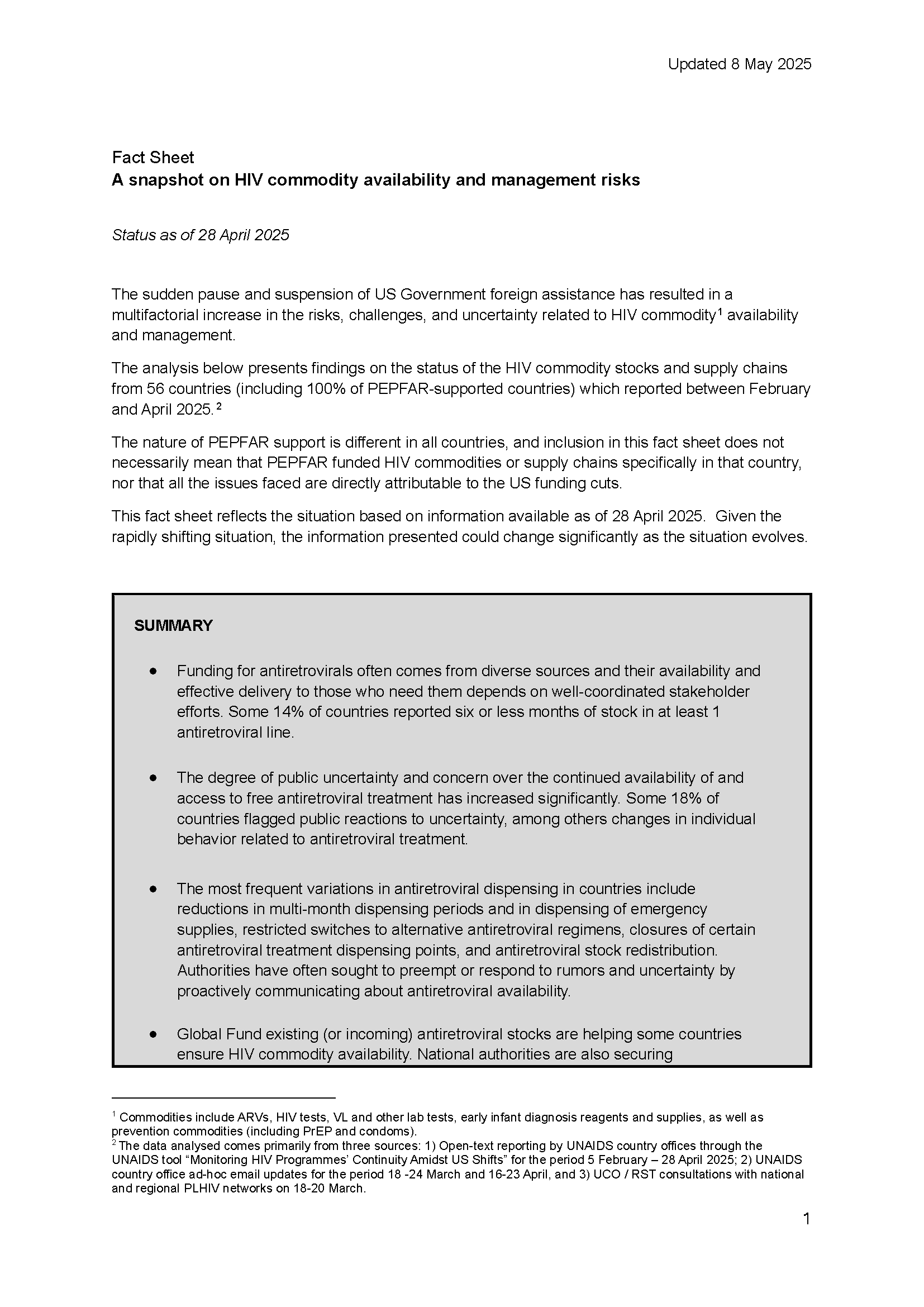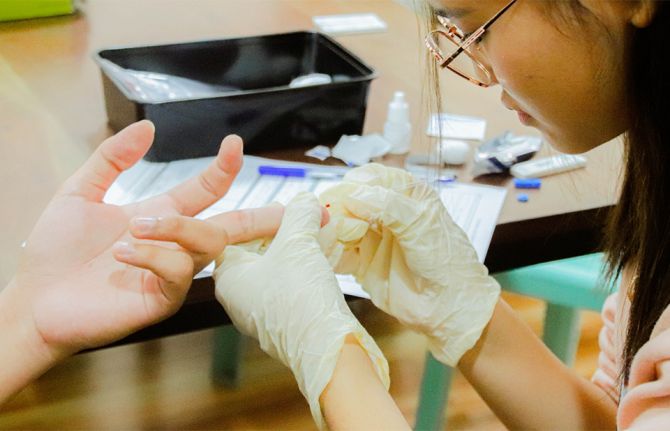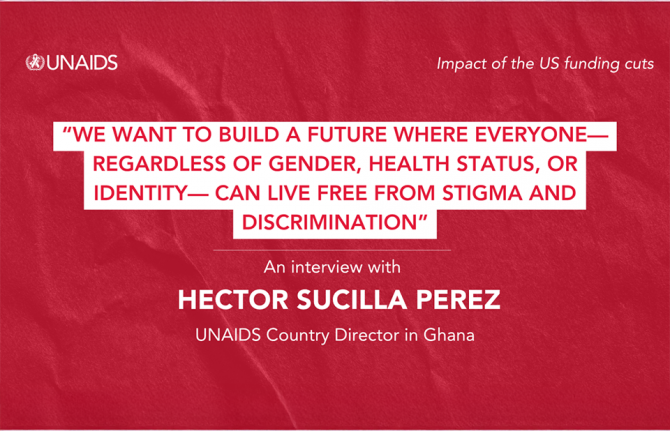

Feature Story
Impact of the US funding cuts: A snapshot on HIV commodity availability and management risks
01 May 2025
01 May 2025 01 May 2025The sudden pause and suspension of US Government foreign assistance has resulted in a multifactorial increase in the risks, challenges, and uncertainty related to HIV commodity[1] availability and management.
The analysis below presents findings from 56 countries (including 100% of PEPFAR-supported countries) which reported on the status of their HIV commodity stocks and supply chains between February and April 2025.[2]
The nature of PEPFAR support is different in all countries, and inclusion in this fact sheet does not necessarily mean that PEPFAR funded HIV commodities or supply chains specifically in that country, nor that all the issues faced are directly attributable to the US funding cuts.
This fact sheet reflects the situation based on information available as of 28 April 2025. Given the rapidly shifting situation, the information presented could change significantly as the situation evolves.
SUMMARY
- Funding for antiretrovirals often comes from diverse sources and their availability and effective delivery to those who need them depends on well-coordinated stakeholder efforts. Some 14% of countries reported six or less months of stock in at least 1 antiretroviral line.
- The degree of public uncertainty and concern over the continued availability of and access to free antiretroviral treatment has increased significantly. Some 18% of countries flagged public reactions to uncertainty, among others changes in individual behavior related to antiretroviral treatment.
- The most frequent variations in antiretroviral dispensation in countries include reductions in multi-month dispensing periods and in dispensing of emergency supplies, restricted switches to alternative antiretroviral regimens, closures of certain antiretroviral treatment dispensing points, and antiretroviral stock redistribution. Authorities have often sought to preempt or respond to rumors and uncertainty by proactively communicating about antiretroviral availability.
- Global Fund existing (or incoming) antiretroviral stocks are helping some countries ensure HIV commodity availability. National authorities are also securing supplementary domestic budget allocations to ensure HIV commodity availability and management.
- Despite the precarious situation faced by many community-led organizations because of the USG shift, they continue to play a central role in engaging and informing communities, addressing rumors, advocating for mitigation actions, and providing early warning on ARV availability, accessibility and cost.
- Significant disruptions affecting combination prevention commodities have been reported as a result of the USG shift. This is due to the dominant role played by PEPFAR in prevention commodity procurement, distribution or delivery in many countries. Some 23% of countries reported six or less months of condom or PrEP stocks.
- Around 21% of countries reported six or less months of stock in at least 1 HIV testing commodity. Careful monitoring of individualized country situations is necessary to mitigate any possible increase in stockout risks.
- Even when HIV commodities exist in-country, they may not always be reaching health facilities – creating patient-facing shortages that undermine trust in treatment continuity. Some 46% of countries reported supply chain management issues.
- The repercussions of the USG shift on the global HIV commodity markets should not be underestimated in the medium term. Sustained predictability in HIV commodity demand forecasts is essential to guarantee a stable supply, maintain prices, and ensure the availability of affordable generic medicines for national HIV responses.
[1] Commodities include ARVs, HIV tests, VL and other lab tests, early infant diagnosis reagents and supplies, as well as prevention commodities (including PrEP and condoms).
[2] The data analysed comes primarily from three sources: 1) Open-text reporting by UNAIDS country offices through the UNAIDS tool “Monitoring HIV Programmes’ Continuity Amidst US Shifts” for the period 5 February – 28 April 2025; 2) UNAIDS country office ad-hoc email updates for the period 18 -24 March and 16-23 April, and 3) UCO / RST consultations with national and regional PLHIV networks on 18-20 March.




